Here’s how we increased average session duration by 281.05% & reduced post promotion CPC by 70%.
Content is subjective.
People like one style or another. They hate one writer or another. They love long, eloquent, flowing prose, or prefer short, snappy, staccato bursts.
The problem is that content marketing efforts are also becoming a zero-sum game.
The rich literally get richer while the poor continue to languish in obscurity.
That means ‘more’ content creation won’t work unless it’s ‘better,’ too.
Yes, quantity is still important. But if quality is subjective, how exactly do you plan your content strategy around making something ‘better’?
Or even proving it to customers, bosses, and clients?
That’s what we set out to answer in this content marketing case study.
Results Summary
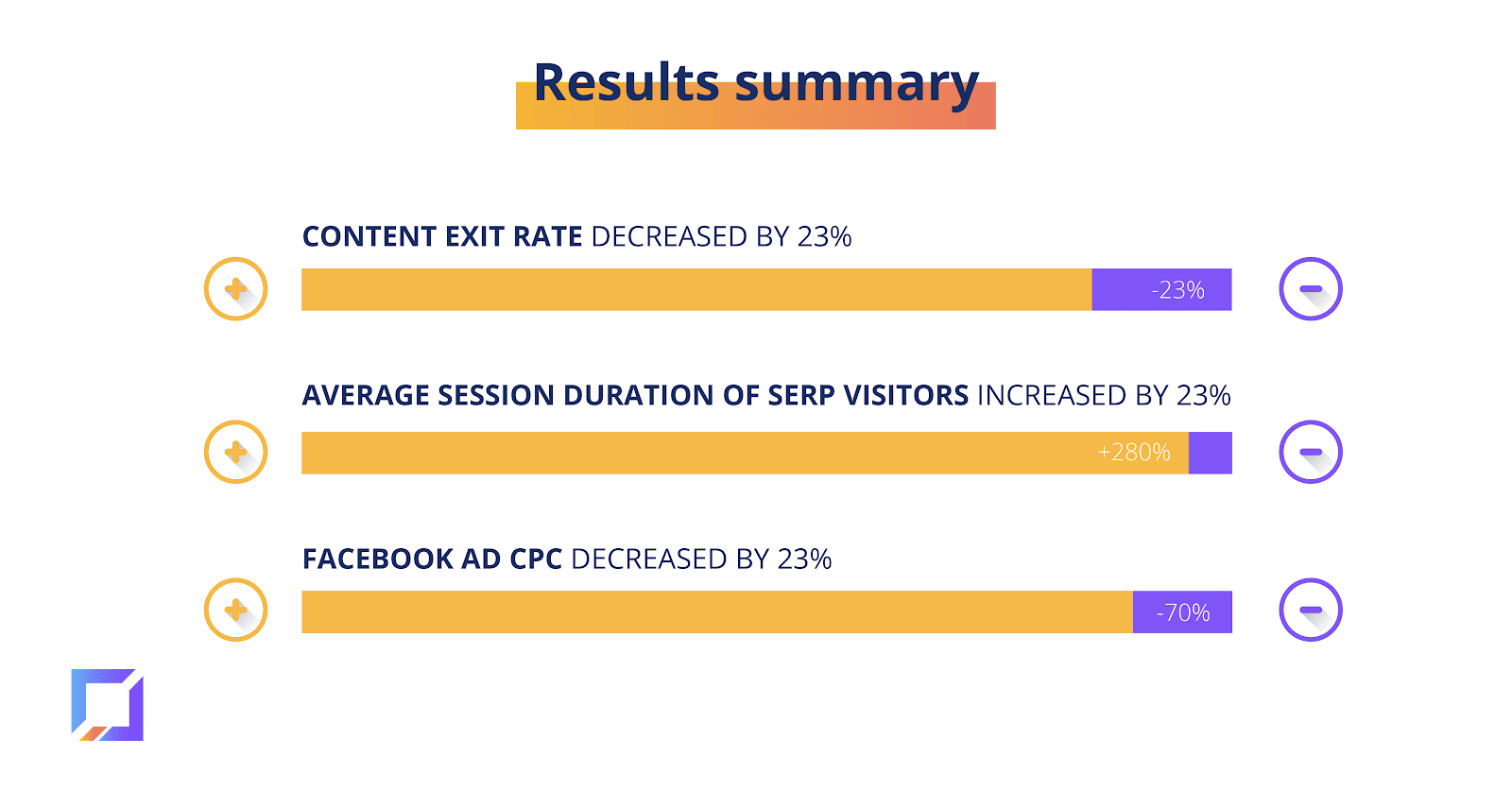
We re-published old content and generated the following results:
✅ Decreased the content exit rate by 23%,
✅ Increased average session duration of SERP visitors by 280% and,
✅ Decreased Facebook ad CPC for that content by 70%.
Please keep in mind this isn’t an SEO post. Nor an analytics one. It’s a content one. So we set out to gather clues from different data points to determine:
- Is this content doing its job? Why or why not?
- What do we do to correct that with the least amount of effort to yield the highest return?
We’ll start by showing you the initial results, before touching a single word. We’ll walk you through the improvements and updates we made. Then, we’ll show you the results — and how those results changed based on the influence of new traffic sources.
TABLE OF CONTENTS
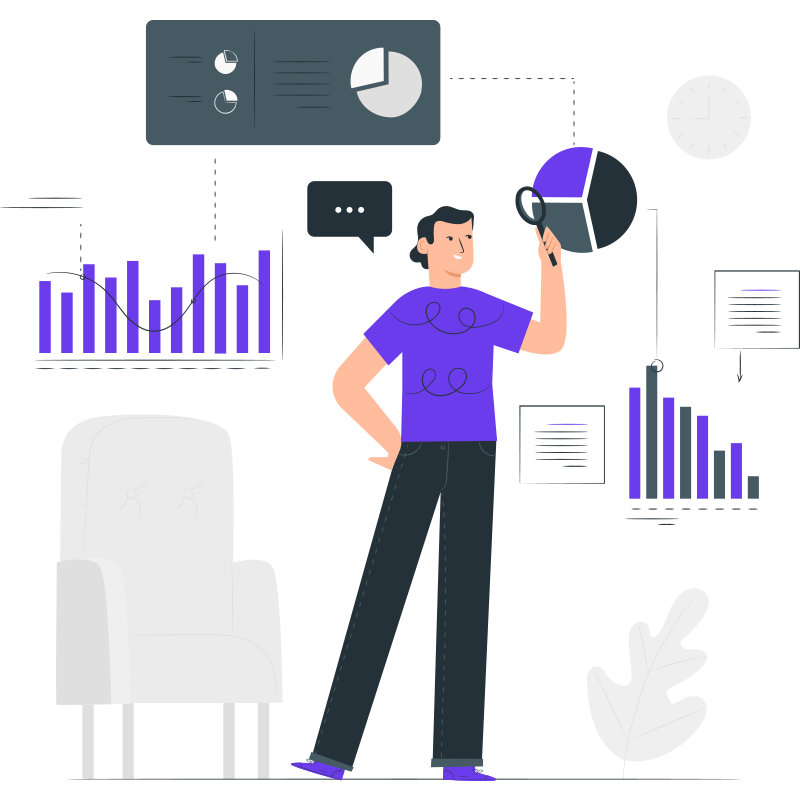
Get long-term ROI.
We help you grow through expertise, strategy, and the best content on the web.
Pre-Revision: Analyzing the Existing Content Performance
New content gets all the headlines. It gets all the attention, and interest, and budget. That’s why for most people a content marketing strategy usually involves a high volume of new content creation.
However, you can often see a bigger jump by revamping old content that does OK, but not great.
Reason being…
This stuff is already known.
It’s already got some Google street cred (i.e., it already shows up in the search engine). Giving it a little TLC can provide a much better bang for your buck when you’ve got a head start.
So we dug through Google Analytics, looking for a good republishing candidate. Typically, those are:
- Posts ranking well, but not well enough (think: bottom of page one or top of page two)
- Posts targeting keywords with easy competition (relative to your own strength)
- Popular posts that leak visitors (ranking well, tons of visitors, but terrible bounce and exit rates)

That leads us to an old article ranking for “b2b marketing ideas.” Check out the new version here.

Pretty low volume. But similarly low competition.
In other words, a perfectly fine top-of-the-funnel blog post keyword in an otherwise crowded niche.
Keyword research is like Monopoly for small sites with low authority. You buy property, add houses over time, then trade those houses for hotels and make bank.
This approach will outperform any overcomplicated marketing plan most of the time.

That’s what we’re doing here when creating content. We already bought the property, but we need to demo what’s there and bring it back into the current century.
[Additional reason why we chose this one to test: We fall into a weird scenario where we actually create content for many of the top SERPs in our space for other big-name sites. So we often get into a trap of potentially competing against ourselves. Which is why we also, from time to time, write content with no keywords, personal stories, or ones with little-to-no relation to our services.]
Here’s a quick SERP snapshot from a couple of months back. You’ll notice our big listicle occupying the fourth spot.
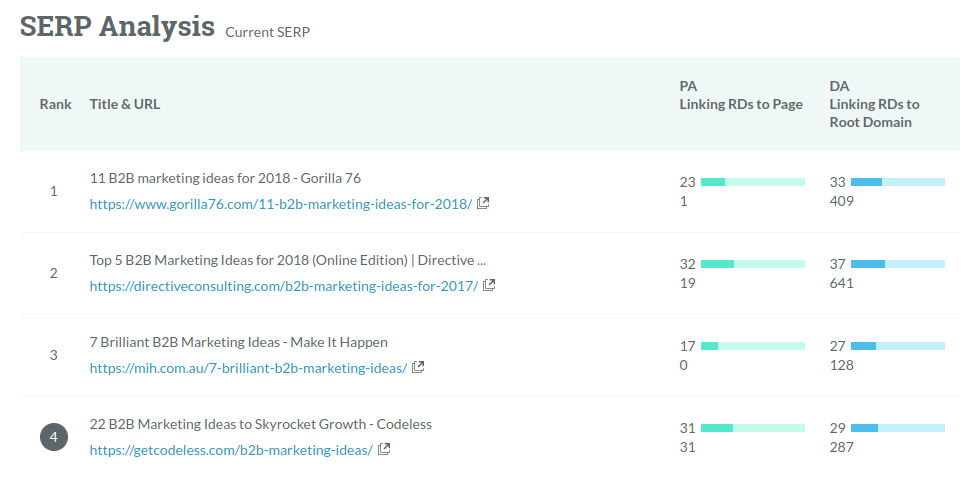
However, based on PA and DA alone, we should at least be in the third spot — if not higher. (That’s another clue to look for when republishing old content.)
The other reason we ranked lower than we should have was that the content was admittedly… not good. It was long. Probably too long. Like 5-6k words. Tons of tactics. A lot of it outdated.
Tons of information. But very little insight.
Here. Check it out for yourself. Click here to see the old version.
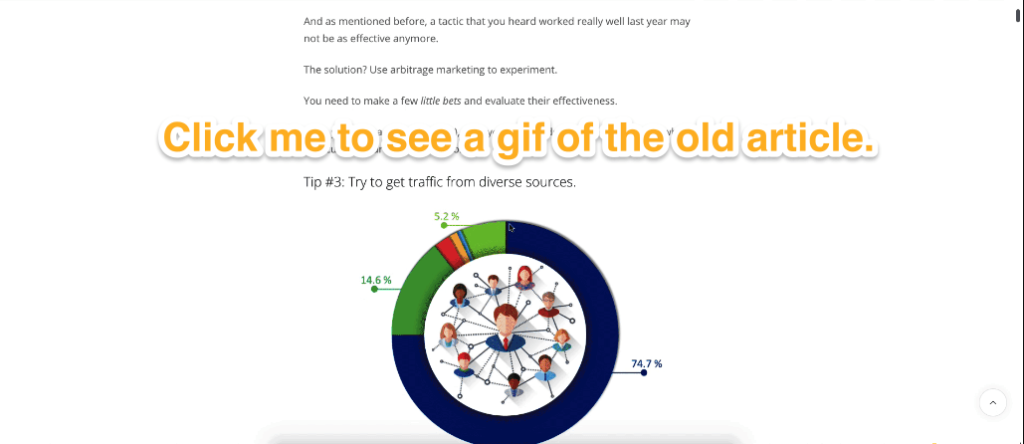
That’s a problem.
The intangibles of ‘good’ writing are often what separates the good stuff from everything else online.
Pinpointing just one thing is tough. It’s hard to verbalize. Traditional blog KPIs don’t always convey it.
You just know it when you see it. (Or read it.)
The third clue this post needed a remodel was the engagement behavior. An un-optimized post ranking fourth is good. Right?
Well, not really.
And it’s also a perfect example of why metrics like visits or rankings aren’t good content KPIs by themselves.
Here’s why:

You’re looking at organic search visits over the period of a few months.
The first warning sign is an 89.61% bounce rate, which isn’t ideal. But not always a deal breaker, either. Context matters. The second issue, though, is that 88.86% exit rate.
Pretty terrible to be honest.
Now, let’s zero in on the Behavior Flow Report for this specific page so you can spot how painfully obvious the problem is. The date range is June 14, 2018 – July 14, 2018.
176 visits come in. And 174 promptly leave the site without looking at anything else. That’s 98.9% of traffic going right back out where they came in.
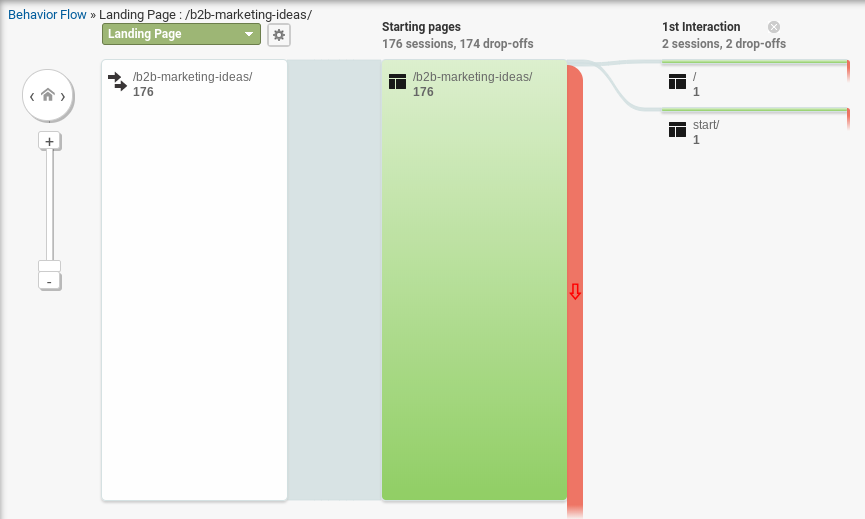
This only displays results for a single month. But you get the idea. The evidence is damning.
The remaining TWO visits clicked through to our home and contact pages. (You know, the ones that ultimately make us money.)
For those keeping score at home, that’s a 0.0057% click-through rate. CLICK-THROUGH.
Not exactly gonna pay the bills.
You can mask a lot of problems with volume. Millions of visits a month, converting at that rate, wouldn’t be cause for an alarm.
Plus, blog content (vs. branded, commercial ones) will always see higher-than-average exit rates, based mainly on how people find those pages (more on that in the advertising section below).
But most B2B related keywords are low volume. So you gotta squeeze every last ounce of value.
What, specifically, was the problem with this piece?
In short:
Everything.
It needed a gut job. And that’s exactly what it got.

Update #1. Rewrite from the Ground Up
Skyscrapers might get all the headlines.
But long doesn’t always = “good.”
In fact, many times, more concise is better. Short copy can improve engagement.
That was the case for this keyword, where the initial recommended text length from SEMrush’s SEO Content Template was only around ~1,500 words. Well short of what most ‘gurus’ recommend.
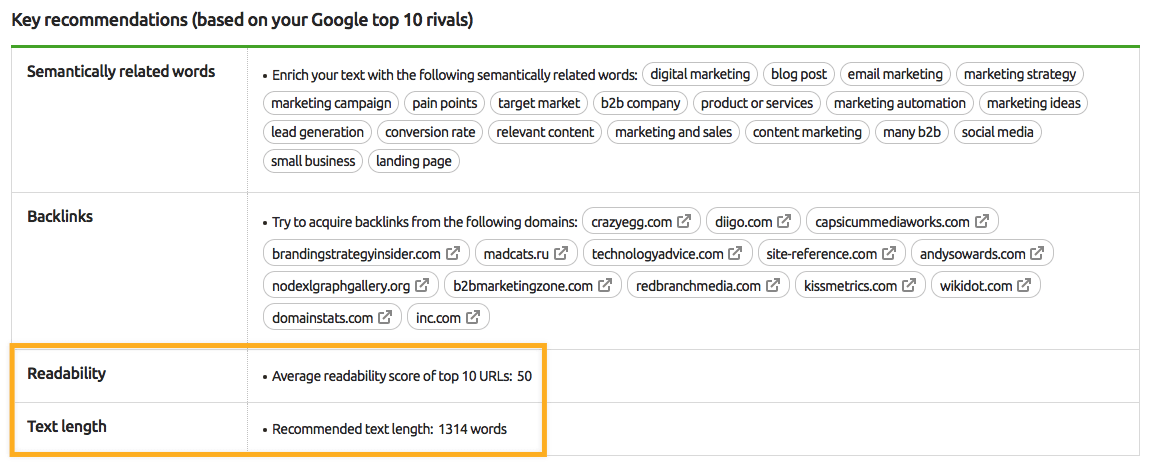
So the first step we took was to completely rewrite the piece from the ground up. It had around 5-6k words before. But we took it all the way down to 1569.
There was some good stuff in there. Camouflaged by a lot of not-so-good stuff.
Which was then buried under a pile of shit. 💩

Unfortunately, this is also the part you can’t fake.
Good writing comes from good writers. Who not only write well but also possess subject-matter expertise.
Plain and simple.
There are no shortcuts when your other options, like content writing services, literally aren’t worth the space they’re typed on.
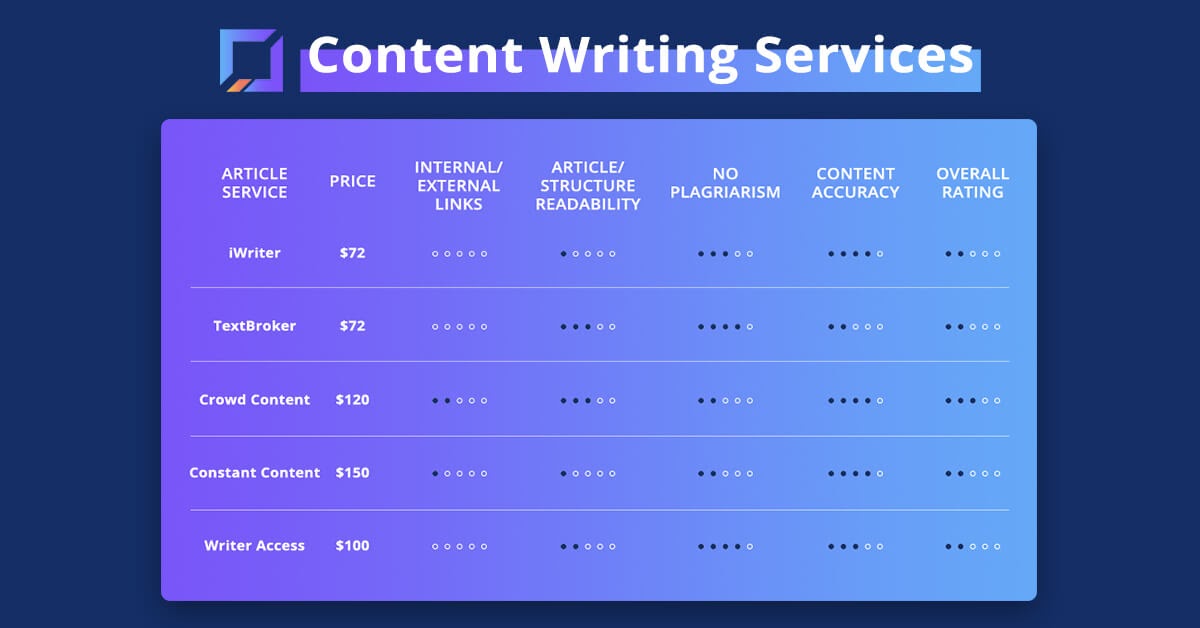
Yes, there are lots of things you can do here or there. Next, I’ll show you how we added custom images, video, and more.
But if the writing sucks, all the other stuff is still lipstick on a pig. Creating content in an attempt for lead generation, or social shares is hopeless if the content itself is not compelling.
There’s a reason ‘good’ content costs a lot. There’s a very tiny cross section of people who understand the technical stuff, while also being able to clearly communicate the technical stuff at the same time.
In other words, you want to make it more interesting to read, without sacrificing readability.
That’s a tricky tightrope to walk. Those two elements are often opposites.
In an effort to reach a more sophisticated audience, you use big words with too many syllables, compound sentences that seemingly run forever, and pile on dense paragraphs that are difficult to weed through.
A hallmark of ‘good’ writing is to explain complex concepts simply.
You can use the Flesch-Kincaid readability test to check for this.
The recommended score for this “b2b marketing ideas” keyword was 50, which puts you around a ~12th grade (or college-level) reading comprehension. It’s considered “difficult to read.”
You might go lower for a more sophisticated audience for thought leadership pieces (Harvard Business Review is in the 30s), while a higher is better for the mass market (Reader’s Digest is in the 60s).

But you somehow need to walk that content creation tightrope without falling too far one way or the other. Otherwise, all this work backfires.
When we finished the rewrite on this piece, we re-tested the new version against more third-party data to validate the work.
The SEMrush SEO Writing Assistant can be used in either Google Docs, or directly in WordPress. Set the target keyword, and it’ll give you a direct competitive analysis based on what the other top ten SERP results have in common.
Our new copy got a “Perfect” overall score, balancing both readability and word count.
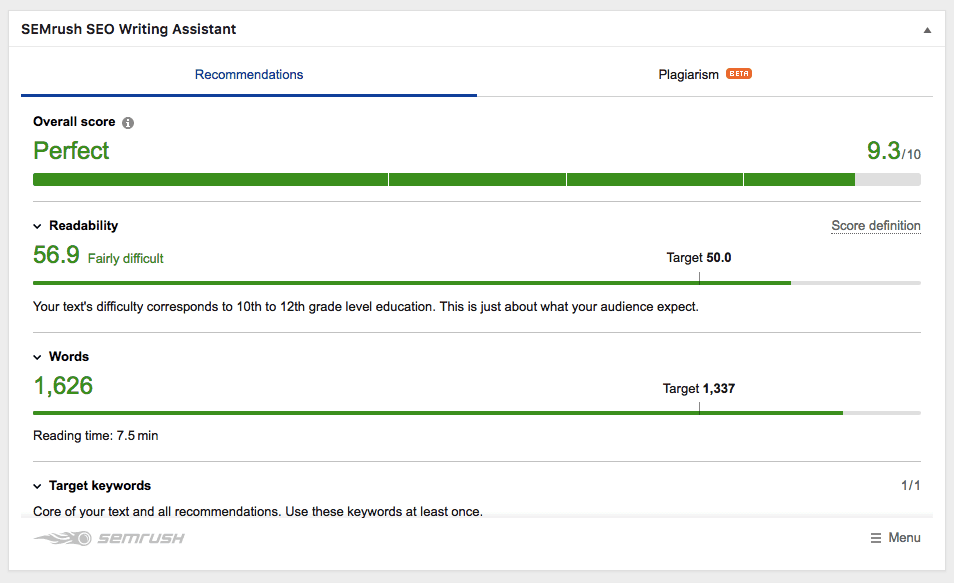
Scrolling down, the tool will also show you basic SEO data like which semantic keywords you should include (and which ones you did or didn’t add).
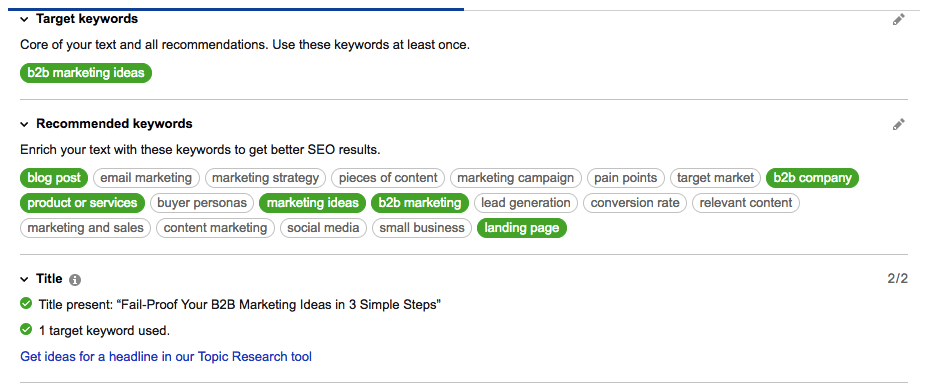
Obviously, this analytics tool is just scratching the surface.
But they do provide quantifiable metrics from unbiased third-party tools you can use to help gauge content quality (besides leaning on years of experience in both writing or subject-matter expertise).
This rewrite was a good start. But it wasn’t enough. Not in a world where only the best of the best get ranked, clicked, and shared.
Toss in ever-shortening attention spans, and you’ve got a problem. A fever.
And the only prescription is more cowbell media.
Update #2. Make Content Easier to Consume
Words are good.
But they’re the start. The foundation that you build off.
Using only words doesn’t always work. Unless there’s a reason.
Otherwise, your goal is to make content easier to consume.
You do that by making it more digestible. By incorporating more elements so people can jump around faster, get the gist faster, and comprehend the nuance faster.
On the surface, that applies to things like links. Both internal and external. Internal ones help shape a site’s architecture and give people contextual points of reference without info-vomiting all over them.
Same goes for different types of media (images, audio, video), UX items like in-post navigational anchors, and even lead magnets like content upgrades.
Then, you can set simple benchmarks to hit. Like ‘X images for Y words.’ Like one image for every ~200 words.
Just be careful setting arbitrary metrics like this that are too aggressive. You can take it too far. And it can create an unintended consequence.
For example, requiring your blog writers to add ~20+ links in every 2k word article forces writers to curate, instead of elaborate. It’s impossible to write anything or to string together coherent sentences when you’re forced to jam in an artificial link every other sentence.
It’s like a negative externality. Seems simple on the surface, but it’s a recipe for disaster in practice.
Instead, you need a healthy balance. Not too much of one thing at the expense of another.
Here are a few of the things we added to the new article copy.
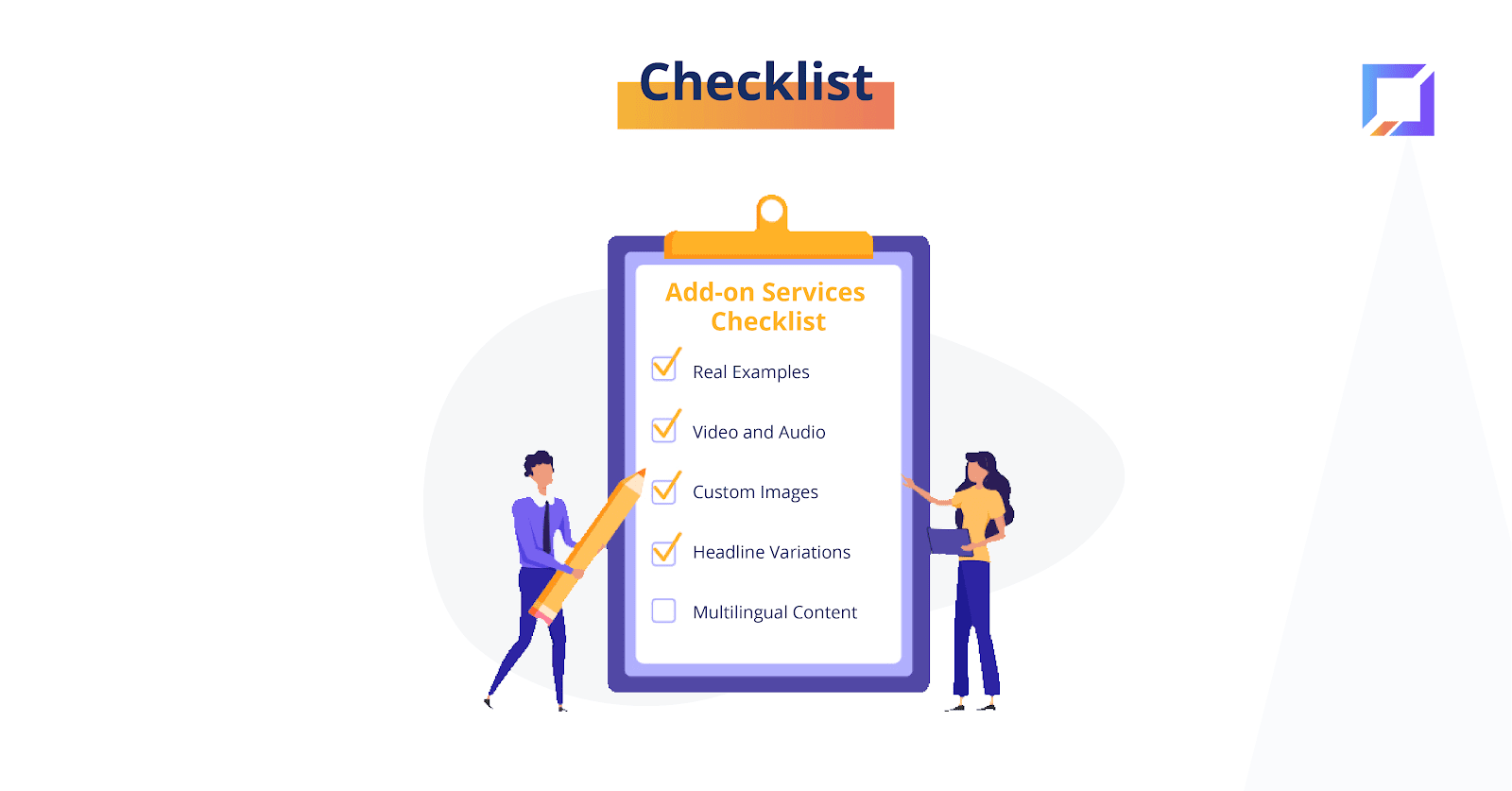
✅ Real examples
What’s one difference between good vs. bad writing?
Specificity.
Bad writing is generic.
Good writing is specific, using real-life examples that immediately engage an audience. You earn their attention because the stuff you’re talking about is exactly what they’re struggling with on a daily basis.
Case in point:
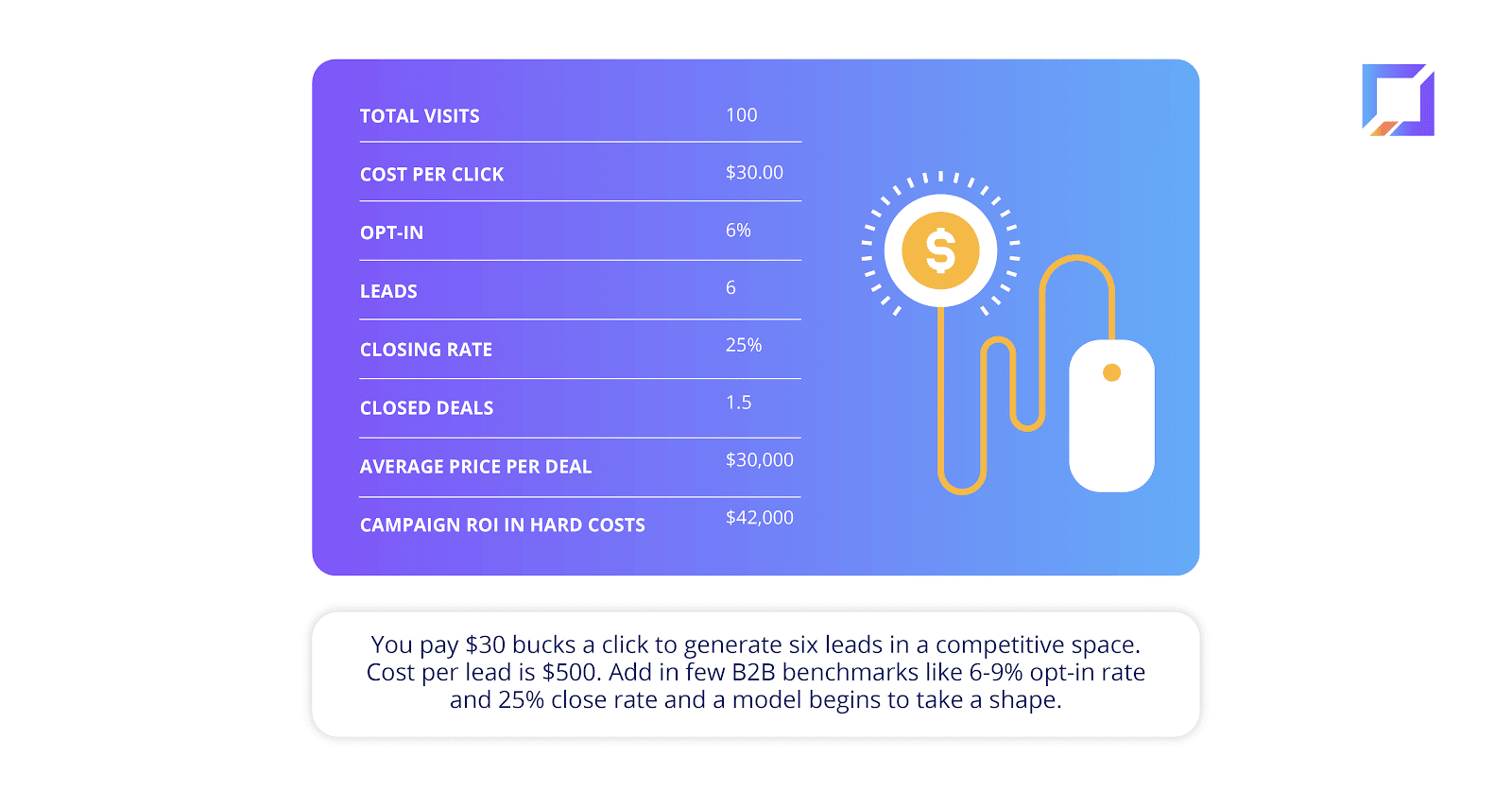
And specificity is the simplest way to spot a good writer from a bad one.
Bad writers write vague sentences. Good ones laser-focus on the reader’s end goal. And do so in their own language.
✅ Video and audio
The world doesn’t need another video marketing stat.
Because you already do it. You already live it.
You click the video at the top of the page because it’s easier and faster and more entertaining than reading the thousands of words underneath.
So help other people do that, too. The tricky thing with video editing, though, is concision.
Only a minute or less will do. Which equates to like ~50 words if you’re lucky.
Somehow, you need to get your point across that quickly, summarizing thousands of words into a dozen or two, while still hooking people’s attention to entice them to click.
Video and audio also provide the added bonus of content repurposing.
Instead of firing off ten bad text articles, you can do half that, incorporate more media, and still increase content creation output at the end of the day (reusing the media across every channel imaginable).
Visual content also helps your target audience get your message, even when they can’t hear the audio.
Many content marketing strategies rely on social media, right? Getting customers to avail your offers on social networks is an important part of content marketing.
Your potential customer may be browsing Twitter, Facebook, Instagram, Youtube, or reading your blog post during work hours. They may not be able to listen to your message.
But they can see it.
Using video captions with engaging content is a digital marketing strategy that has been a proven winner.

✅ Custom images
Some smart peeps are already on this bandwagon.
Custom images should enhance what the text is saying. Should illustrate the point you’re trying to make.
Custom images for headers might look nice. But they also lack the deeper connection to drive engagement through the roof. They make good content into great content.
Instead, illustrate comparisons you’re making between one thing and another:
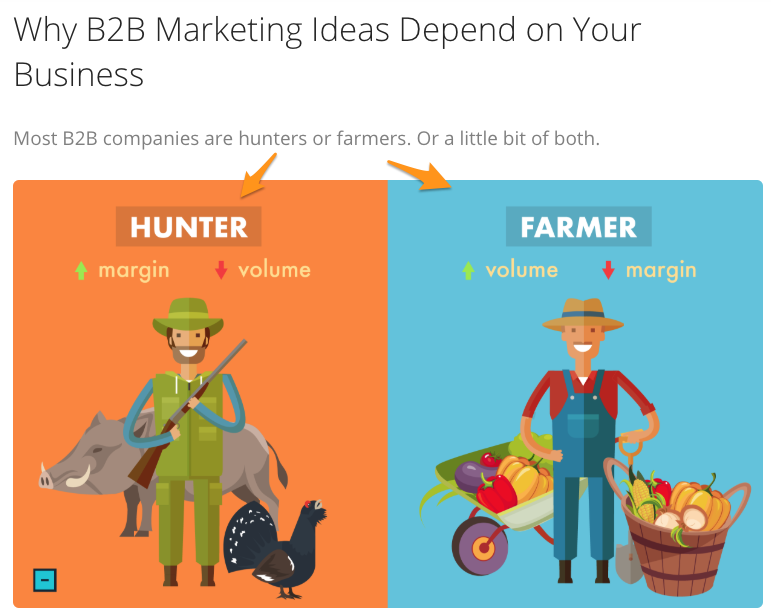
And use custom images to help explain complex topics with less fuss. Do it well, and the net effect is better reader comprehension with less time or energy required from them. More calories burned despite more time on the couch.

✅ Headline variations
Content results differ based on the audience. Not just the individuals. But also the traffic source.
That’s why short copy works well with intent-based search users, while longer is better for cold traffic from ad campaigns.
Same applies to content. Except, in this case, it relates to engagement (as opposed to conversions).
All we’re doing in this case study is (1) isolating variables and then (2) setting out to improve them.
And there are perhaps no greater variables than the headline that gives people a reason to click and read (or not).
The problem? ‘Headline analyzers’ sound nice in theory, but can’t actually predict winning headlines.
Which means you gotta test variations for yourself. Which means you gotta figure out how to do it. And then actually, you know, do it with multiple headline variations based on legit copywriting principles.

Thrive’s Headline Analyzer compiles several different metrics to decide on the ‘winning’ headline. That way, you’re not falling victim to a false-positive headline that gets a lot of clicks but a ton of bounces to go with it.

✅ Multilingual content
Kinsta’s Spanish Hosting Launch got our wheels turning after interviewing CMO Brian Jackson for a Canva piece.
They didn’t just stop at content, expanding into everything from a Spanish site through to the back-end dashboard of their hosting app.

Most large SaaS companies are already aggressively expanding into other international markets. But are they pursuing multilingual SEO as aggressively?
That got us thinking.
If we’re already doing best-in-class content in English, let’s handle the translation piece, too.
After all, a quick look at the Geo report inside Google Analytics will instantly display international hotspots for everyone. It’s not hard to determine who’s visiting your site. What’s hard is actually doing something about it.

Why don’t more companies already translate their sites into several different worldwide languages?
Because it sucks.
Sure, there are automation tools out there that will translate your content. Polylang is one option. But none capture the extra 10% that makes excellent content excellent.
Translating “the” and “but” and “keyword” is the easy part.
The problem is nuance. Slang. Jargon. Jokes. Context.
That’s the shit that gets lost in translation. Literally and metaphorically.
So if your goal is excellent content, and not average crap, then half-assing it with some push-button translation ain’t gonna cut it, either.
Instead, you gotta go the old-fashioned route. You gotta roll up your sleeves. You gotta source human translators, test them to see which best captures context, and then manage quality over the long-haul to do it at scale.
Kinsta built their own Spanish-speaking team. That’s ideal, but out of reach for most. Especially when you’re talking about taking every content piece and translating it into two, three, or four+ languages.
We’ve tested this internally on this post, and are now offering it to clients, doing translations in French, Italian, and Spanish for now.
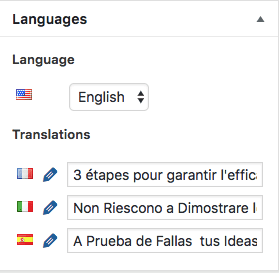
Here’s an example of how this article republishing came out in French:

(Don’t ask me what this says. I can barely speak English properly. We have a native-speaking consultant fact-check the initial human translators.)
You can schedule a call to find out more about these new content Add-On Services.
Re-Publish Results: Exit Rate Dropped 23% and Average Session Duration Increased 281%
Not long after republishing, the post climbed a spot to the third SERP position.
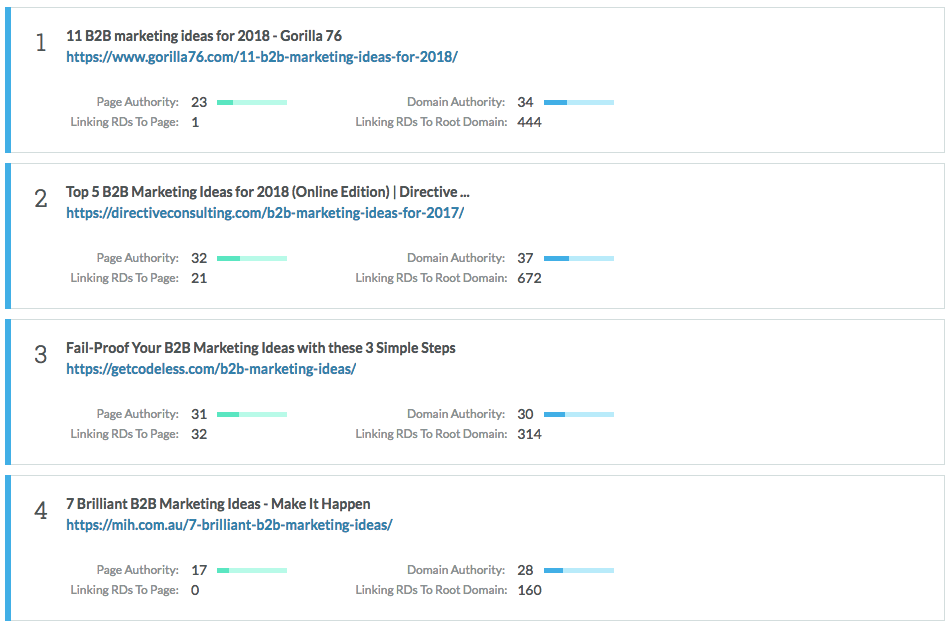
… without any extra promotion, referral traffic, backlinks, social mentions, or advertising.
Site engagement does influence rankings.
How so?
In the month after republishing, bounce rate and exit rates both improved.

Bounce rate dropped by 5.81%, while the exit rate declined 22.94%. That’s massive considering it was previously over 90%.
However, these were aggregate scores across all page views.
Let’s go back and look at this page’s engagement metrics as the entrance page from SERP visitors to compare apples to apples.
New sessions did drop slightly. We didn’t want external promotion to influence results at this stage. So I’m assuming either (a) search volume was down across the board during a slow summer, or (b) our SERP CTR temporarily dropped during that time.
Either way, though, the keyword is so low volume that it’s hard to draw any definitive conclusions. A handful of visits one way or the other could just be a normal fluctuation.
Otherwise, and more importantly, engagement metrics increased significantly from the all-important, all-purchasing, intent-based SERP visitors:
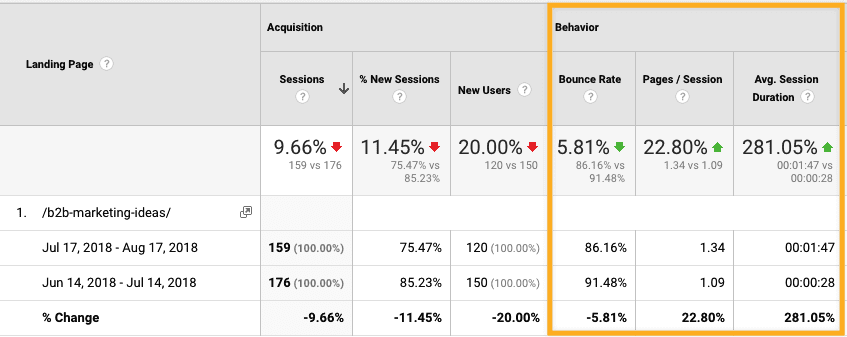
- Bounce rate declined 5.81%
- Pages/session improved 22.80%
- Average session duration jumped 281.05%
Increased content time on site = better odds at driving the initial micro-conversion you’re after.
Again, the focus is purely on SERP performance. No external traffic sources skewed this data (even though republishing an old rewritten post would have been an easy, low-hanging fruit).
The reasoning, as alluded to several times already, is that content performance is often at the mercy of the traffic channels you’re using to drive people to it.
Here’s why.
Bonus Round: 70% CPC Savings on Facebook Distribution
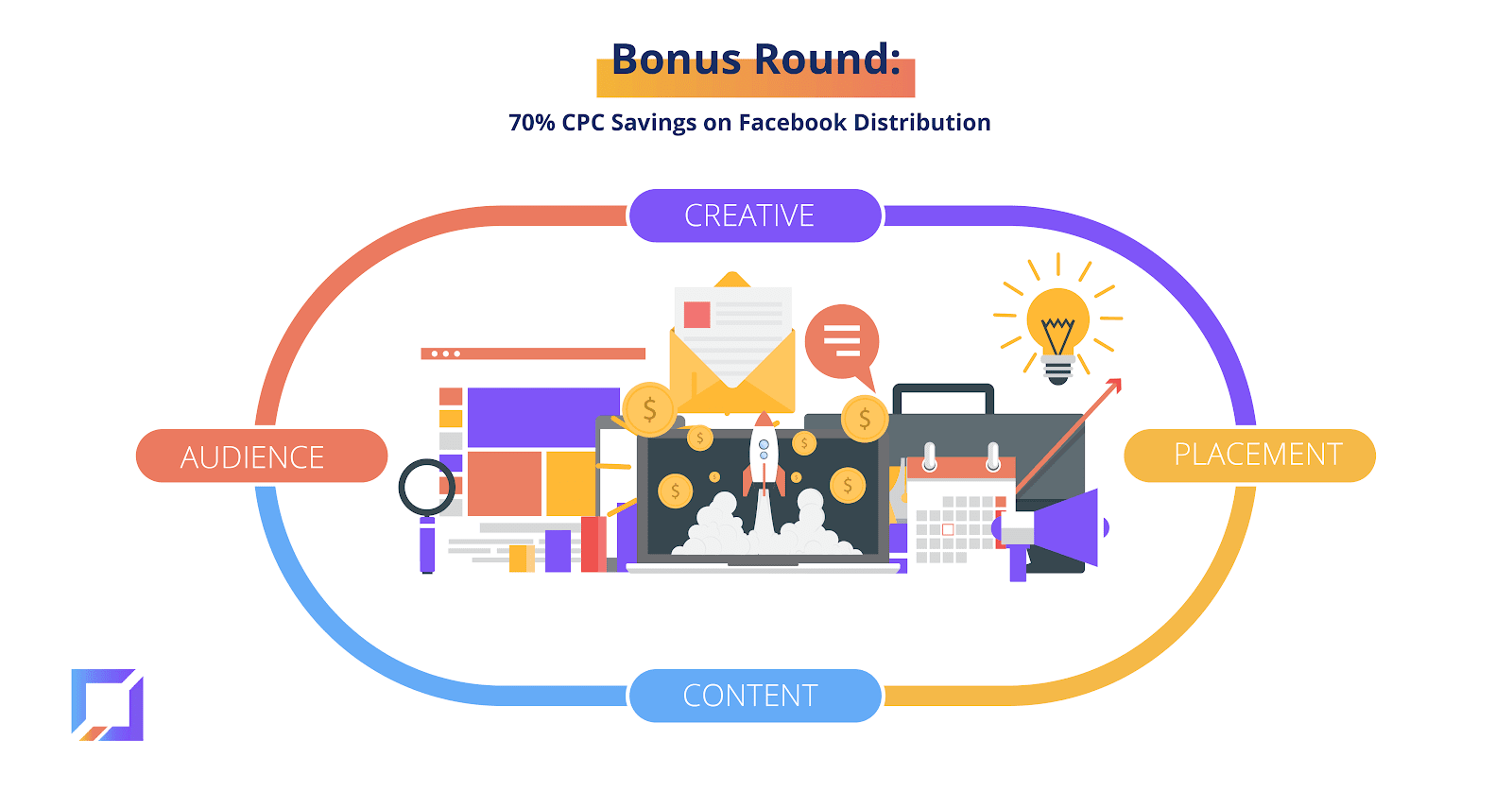
Creation isn’t distribution.
The ‘success’ of content can’t be judged in isolation. It can’t do it all on its own.
Instead, it’s heavily reliant on the distribution strategy used to get the word out and generate the right eyeballs where it matters.
We wanted to add another layer of complexity to (a) accelerate short-term results and (b) analyze the impact of our digital content add-ons like custom images or video on the ad campaigns themselves.
Audience
Here’s how scientific the audience-building portion was:
I just randomly listed off a bunch of relatively well-known marketing brands under Interests.

I then chose people in North America, aged 25-50, and left all placements intact. This way, we could also rule out cheap, worthless clicks that would never potentially convert.

Super sophisticated.
But the point was to use a generic, saved audience that anyone, anywhere could use.
Yes, we could have saved a ton of money and seen much better results with a custom target audience we’ve spent years and thousands nurturing. However, it also would have introduced some bias for this experiment and provided an unfair advantage, too.
So we willingly wasted a little over a hundred bucks. In the name of science!
Here are the aggregate campaign results, using the super beautiful and easy to use AdEspresso. (Who may also happen to be a client. But we still pay for the service in this case.)

We stopped this example so quickly because the results (featured under Ad Split Test below) were already trending in a predictable direction. And we were just trying to drive content views (or clicks), so there was no need to willingly flush money down the drain trying to chase some Unicorn-esque, statistically significant conversion numbers.
Here, again, are the saved target audience details to drive the above results:
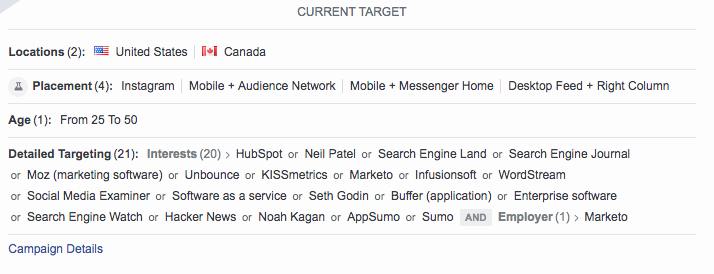
Now. Why are we spending so much time on the audience?
What does this have to do with distribution vs. creation?
Your audience targeting will ultimately have the biggest impact on campaign (and content) performance.
Here’s another example that proves it. The two campaigns below feature the same exact ads for the same exact piece of content.
Yet one drove CPC at only $0.17 vs. the other at $0.57 (for a 70% cost savings).

Same exact content. Same exact ads. Different audience.
But we’re not done yet.
Because we were also able to decrease CPC by another 70% with better ad creative.
Ad split test
Creating custom, branded images and video didn’t just help on-site content performance.
It also provided us with ammunition for creating better ads, too.
Repurposing at its finest. One little investment boosted page engagement and lowered ad costs.
Here are the three ads we created for this campaign. The headline and description copy were exactly the same. The only difference was the media asset.

- Custom: We used one of the custom, branded images edited specifically for this piece of content.
- Featured: We next opted for the featured blog post image, which makes up like 99.9% of most other social images for blog content we see around the interwebs.
- Video: Last but not least, the video commercial was picked to see if a short clip might entice more interest.
The Custom variant won out, posting a $0.439 CPC. The Featured one, despite being the default for most company’s social promotions, performed the worst at $1.486 CPC.
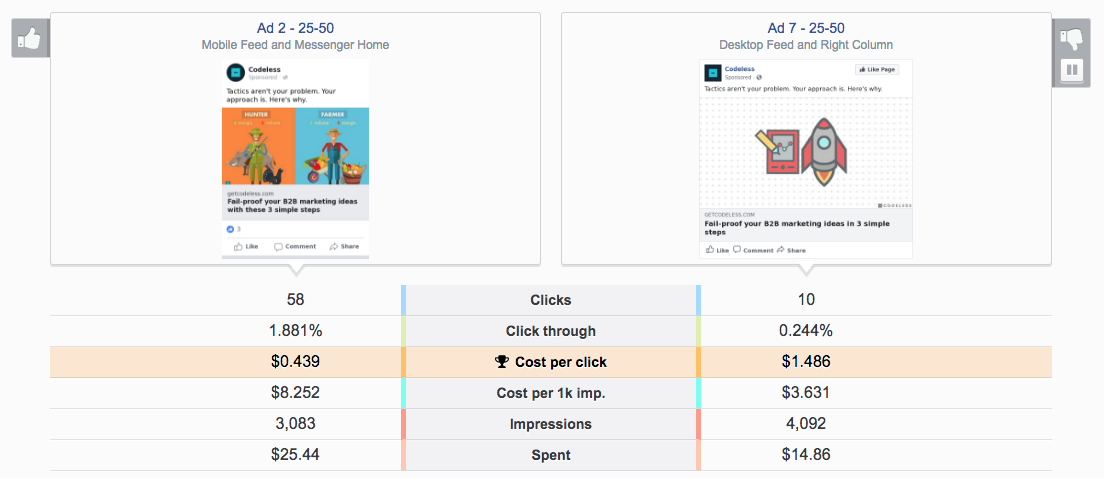
Meanwhile, the Video option came in close behind the Custom image with a $0.617 CPC and 1.051% CTR.
That’s another 70% CPC cost savings on social distribution that most companies leave on the table by sticking with default featured blog post images.
If we drove a thousand visits at the same rate, that’s the difference between paying $439 and $1,486 for the same exact results.
Here’s how the three stacked up (red is Custom, yellow is Video, blue is Featured):

Unsurprisingly, the mobile and messenger placements were more cost-effective for digital content marketing than the comparatively crowded Desktop and Right Column ones.

Pretty much all mobile placements (in yellow, blue, and Instagram in red), are going to be vastly cheaper than Desktop and Right Column options (purple) when distributing content.

Assuming you have a Facebook ad sales funnel in place to capture and retarget site visitors, it makes no sense to overpay for the prime real estate.

Here’s another recent content ad campaign, showing how the trend lines will continue to optimize and improve over time when you hit on a winning combination of (a) right audience, (b) right content, (c) right creative, and (d) right placement.

Video view audience
I was a little surprised when the static, custom image outperformed the video. So we set-up one more ad campaign to see if there was another way to lower costs.
Instead of driving link clicks with the video commercial, this time we wanted to build a cheap audience through video views to later retarget with other content campaigns.
The two-second continuous view option allows you to build an audience for as little as $0.01 per person.

Most (if not all) blog content is awareness-based.
It’s the first step, not the last. It’s the introduction, not the conclusion.
By definition, we’re starting with a wide funnel at the top that we’ll use to set-up subsequent ad campaigns to drive middle and bottom-of-the-funnel conversions.
After running all of these tests, we’ve seen content campaigns run anywhere from ~$1.50 to $0.25 per click (depending mostly, again, on the audience you select). Here’s proof of the wide range:

Based on this range, let’s say the video view audience conservatively saves us 0.30 cents per click down the line when we do go to promote the next post.
Multiply by 10,000 clicks to build an audience, and that could save another $3,000.
(Not bad for a video that cost a fraction of that.)
Ad audience content engagement
Now, all that glitters is not gold.
Every action has a reaction.
The cold ad-based audience did have a negative impact on content engagement (vs. the warmer, intent-driven SERP visitors from before).
Our initial goal with these ad campaigns was to drive roughly the same amount of post entrances over the course of a few days.
But unsurprisingly, that had a negative impact on engagement metrics.

The bounce and exit rates over the three-day ad spending spree drive bounce and exit rates up, too.

That’s why you need to choose blog KPIs with care. Because content metrics are often at the mercy of several competing factors.
Starting with the very source of traffic and visitors you’re driving to it.
Conclusion
Only quality content cuts through the noise today.
But defining ‘best’ can be tricky. It varies by product, business, and industry. And most of all knowing your customer and what kind of audience you are appealing to.
Content is subjective. Which means ‘quality’ is often a moving target.
However, you can still quantify content performance. Search engine rankings, social shares, website traffic, lead generation statistics all help to measure the true success of any content marketing campaign.
You can start by carefully selecting which metrics to prioritize (like engagement-based ones) while de-emphasizing other ones that are too heavily influenced by outside factors (like visits or conversions).
You can update and republish content, comparing the new results vs. prior performance in those key categories.
And you can also compare the cost of alternatives, using Google Adwords or social media ad campaigns to create a quicker feedback loop.
Then, it all comes down to executing well — actually improving upon what you already have — to see the clear return on investment.




